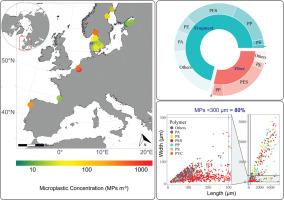欧洲大西洋沿岸水域的微塑料(10µm- 5mm)
Q2 Environmental Science
引用次数: 0
摘要
微塑料(MPs)是沿海水域普遍存在的污染物,引起了重大的生态问题。本研究使用统一的采样和分析方法评估了欧洲大西洋沿岸地区小型MPs(低至10 μ m)的丰度和特征。所有站点都使用了过滤泵微塑料采样器,即“通用过滤对象”(UFO),在选定的位置使用Manta网(300微米网)采样。微塑料浓度范围从10 MPs - m-3到1600 MPs - m-3,芬兰湾的浓度最低(5 MPs - m-3),比利时斯海尔特河口的浓度最高(1603 MPs - m-3)。大多数MPs(80%)为300µm,主要由聚酯、聚丙烯和聚乙烯碎片组成。与UFO采样相比,蝠鲼网采样始终低估了总微塑料浓度和大于300微米的微塑料。河口和废水排放被确定为污染热点,强烈影响当地的MP分布。在这项研究中,在欧洲大西洋水域发现的微塑料浓度中位数低于使用基于泵的采样设备测量的沿海水域的全球中位数。虽然目前的MP水平不太可能对海洋中上层食物网构成直接风险,但塑料产量的预计增加,加上其低降解性和化学浸出,强调了实施缓解措施以防止未来环境影响的紧迫性。本文章由计算机程序翻译,如有差异,请以英文原文为准。

Microplastics (10 µm-5 mm) in European Atlantic Coastal Waters
Microplastics (MPs) are pervasive pollutants in coastal waters, raising significant ecological concerns. This study assessed the abundance and characteristics of small-sized MPs (down to 10 µm) across European Atlantic coastal sites using harmonized sampling and analytical methods. A filter-pump microplastic sampler, the "Universal Filtering Object" (UFO), was employed at all sites, with Manta net (300-µm mesh) sampling conducted at selected locations. Microplastic concentrations ranged from <10 MPs m-3 to >1600 MPs m-3, with the Gulf of Finland showing the lowest concentration (5 MPs m-3) and the Scheldt estuary in Belgium the highest (1603 MPs m-3). Most MPs (80%) were <300 µm, primarily consisting of polyester, polypropylene, and polyethylene fragments. Manta net sampling consistently underestimated both total microplastic concentrations and microplastics larger than 300 µm compared to UFO sampling. Estuaries and wastewater effluents were identified as pollution hotspots, strongly influencing local MP distributions. The median microplastic concentration found in European Atlantic waters in this study was lower than the global median for coastal waters measured using pump-based sampling devices. Although current MP levels are unlikely to pose an immediate risk to the marine pelagic food web, the projected increase in plastic production, combined with its low degradability and chemical leaching, underscores the urgency of implementing mitigation measures to prevent future environmental impacts.
求助全文
通过发布文献求助,成功后即可免费获取论文全文。
去求助
来源期刊

Environmental Advances
Environmental Science-Environmental Science (miscellaneous)
CiteScore
7.30
自引率
0.00%
发文量
165
审稿时长
12 weeks
期刊介绍:
 求助内容:
求助内容: 应助结果提醒方式:
应助结果提醒方式:


